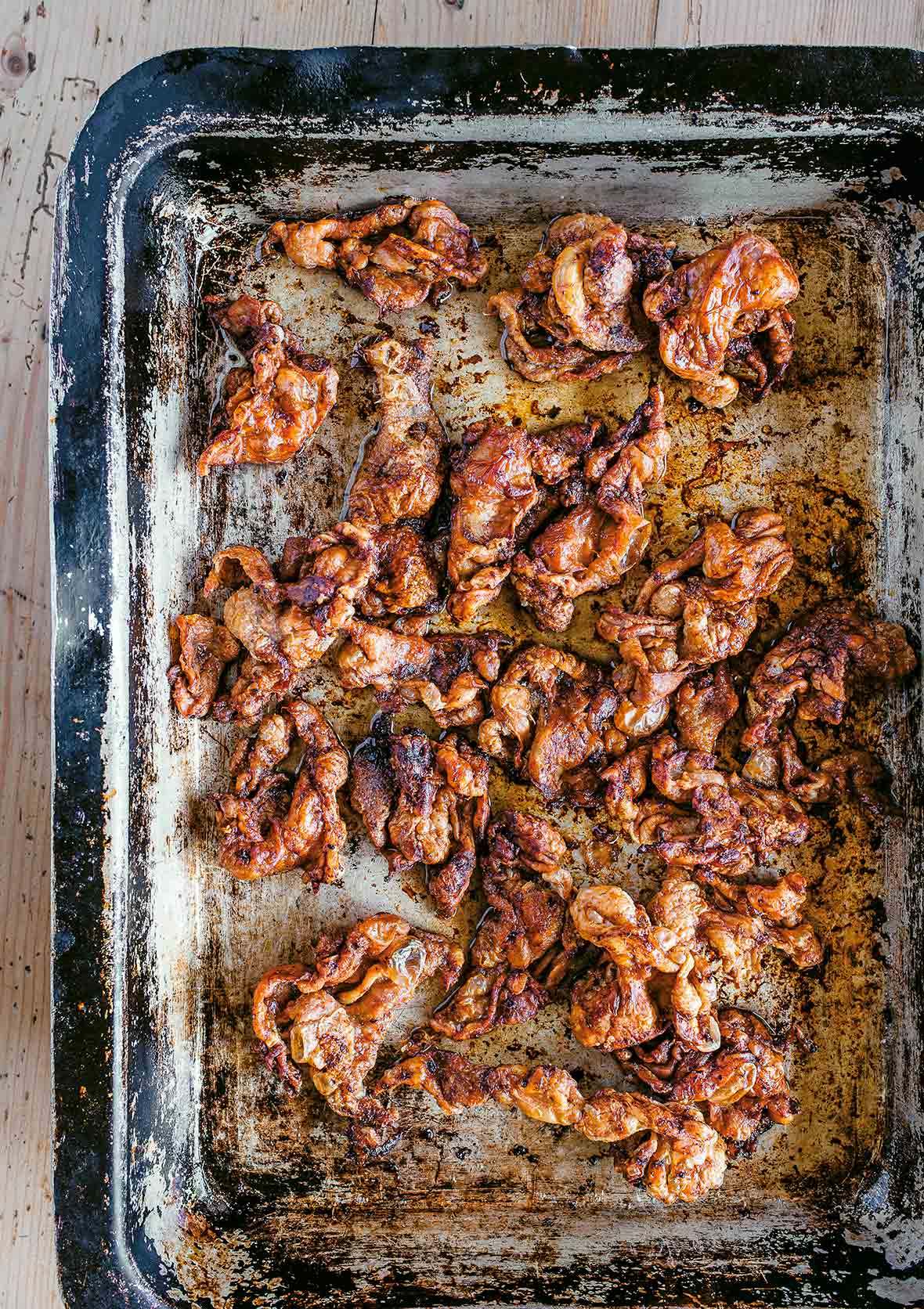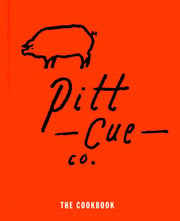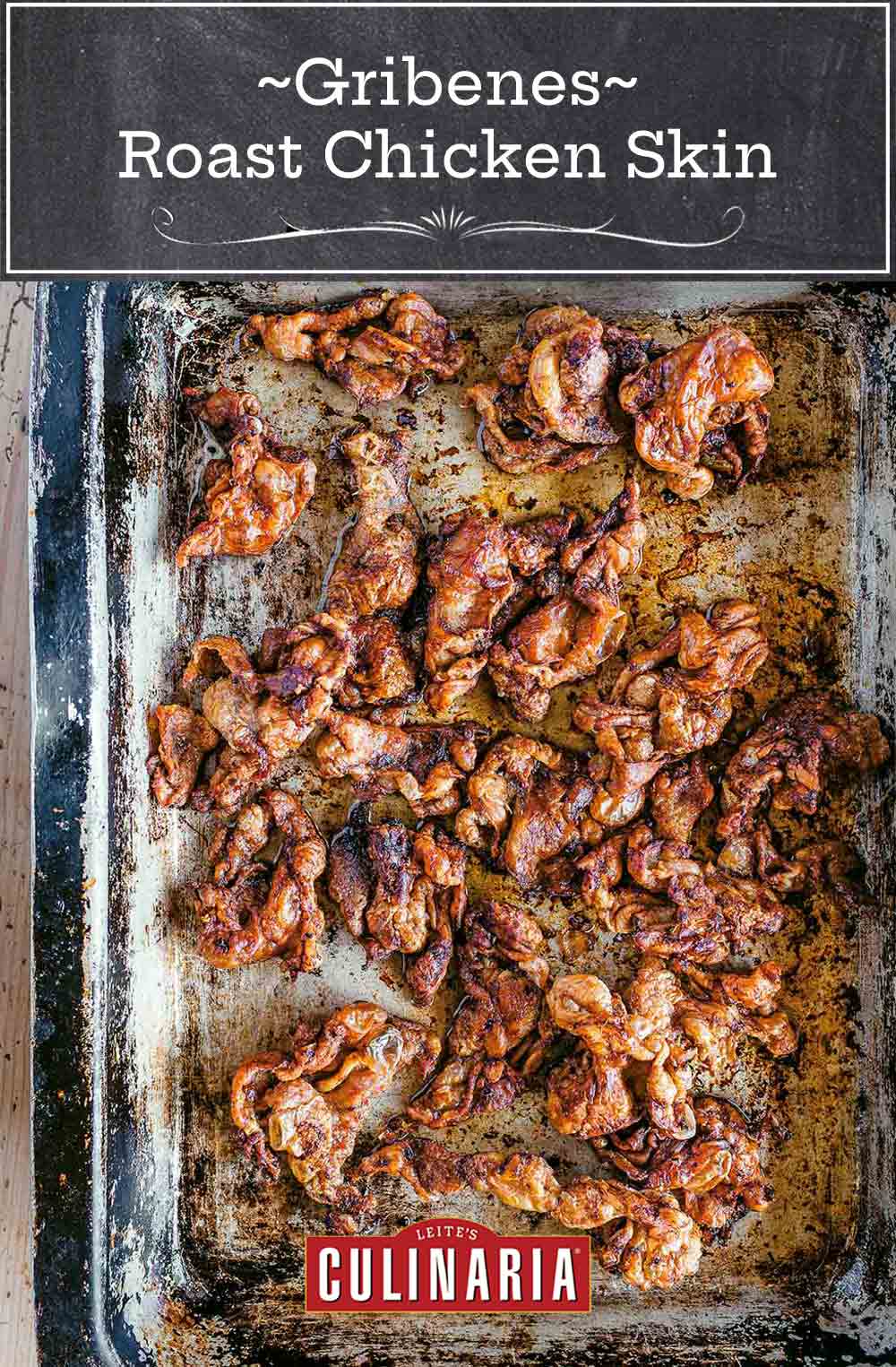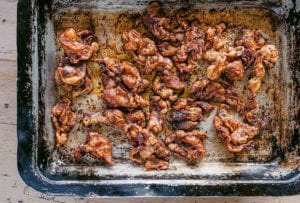
Mmmm. Roast chicken skin. If you’re wondering what relevance this has to you and your life, just think a second. We all know the best part of a properly roast hen is the crisp, crackling, lightly salted, perfectly burnished chicken skin that you just can’t resist snitching and nibbling before sitting down at the table. Except sadly, there never seems to be quite enough to satiate. We know this. You know this. And, thankfully, the authors of this recipe know this.–David Leite
What are gribenes?
Think, for a moment, about the crisp, deep-fried pork skins called chicharrones in Spanish. Consider these roast chicken skins to be chicken chicharrones—or, if you will, an oven riff on gribenes in Yiddish. While gribenes are usually a happy by-product of making schmaltz, or rendered chicken fat—hands-down the loveliest by-product we’ve ever experienced—this recipe celebrates the skin for its own sake. Sprinkle them on salads. Incorporate them into Sriracha deviled eggs. Or simply nibble them at will.
Gribenes | Roast Chicken Skin
Ingredients
- 3 sprigs fresh thyme
- 9 ounces chicken skin, (available from most local butchers), cut into pieces
- 3 tablespoons homemade chicken stock or canned chicken broth
- Sea salt, to taste
Instructions
- Preheat the oven to 350°F (177°C).
- Toss the thyme sprigs in a roasting pan and plop the chicken skins on top. Add the chicken stock, and roast, uncovered, until the skins are nearly crisp, 30 to 40 minutes, stirring or flipping the chicken skins every 10 minutes.
- Drain the fat, called schmaltz, and save. It’s great to cook with.
- Return the pan to the oven until the chicken skins are crisp, 12 to 20 minutes more. (Note, the chicken skins will be more like the crisp skin on a roast chicken than the puffed skin of pork rinds.) Lavish with salt to taste. Originally published September 16, 2014.

Explore More with AI
Nutrition
Nutrition information is automatically calculated, so should only be used as an approximation.
Recipe Testers’ Reviews
Who among us doesn’t LOVE crisp chicken skin? I say to those who reply in the negative, GREAT! MORE FOR ME! This simple gribenes recipe will have you knocking on the back doors of butcher shops and slipping away with chicken skin by the pound. It’s so obvious and yet overlooked.
I preheated the oven to 350°F, tossed a nice bunch of fresh thyme in a preheated cast-iron skillet, added the chicken skin in a single layer, and returned the skillet to the oven. I jostled the skillet every 10 minutes or so to make certain the skins weren’t sticking. I think preheating the cast iron assured me that this wouldn’t occur. After 40 minutes, the skins were nearly done and almost crisp enough. I drained the fat and slid the skillet back in for an additional 10 minutes.
A bit of sea salt and cracked pepper and we had reached chicken NIRVANA. These were so good that, henceforth, I’ll make them on a couple large, rimmed, baking sheets. (Gotta be rimmed. Don’t want to lose that chicken fat and smoke up the kitchen.)
These crispy gribenes are AMAZING on deviled eggs and are sure to make any salad shine. The next plan for these wonderful treats is to add them to chicken salad. A simple word of caution: have the dish you are using these with at the ready, or trust me, they will disappear before they reach their destination.
I don’t know where to start. Did I ever think I would see a recipe for gribenes on a food blog? And frankly, would anyone really be interested in this traditional treat that replaced bacon in many Jewish households? Nothing is wasted, for certain, including the rendered fat/schmaltz that historically was used as Jewish “mayo” on a great slice of corn rye or pumpernickel bread.
The instructions were very clear, and using the oven as the vehicle for browning/rendering was sure better than the fat spatter over my stove top. My go-to method had always been the trusty cast iron but this worked beautifully.
These delicious crispy bits don’t hang around too long. And they are super spiffy with the addition of thyme. Great on a sandwich or salad, and certainly good on a Paleo diet, they are always a treat.
I only had 6.4 oz of skin as my butcher didn’t have any to part with so I robbed a package of bone-in, skin-on breasts of their skins. The cooking times were perfect—don’t skip on the stirring/flipping part. You want the skins evenly crisped and browned. I only rendered 1/8 cup of schmaltz—all the more reason to make this recipe again.
I rub the schmaltz on bread and toast it, then add the crumbled gribenes to chicken salad served on the aforementioned bread. It’s like a really amplified chicken sandwich and is evocative of the Kips Bay wax-paper-wrapped decadence from my 1970’s childhood. Simply magical.
This gribenes recipe is a twofer. Not only do you get crisp chicken skin, but also bountiful liquid gold, also known as schmaltz. The preparation is simple, with the only real work being turning the skin occasionally for even roasting. The addition of thyme adds a nice herbal undertone, but not necessary if you don’t have that around. The crisp skin itself seasoned properly with salt is just fine.
I am surprised this isn’t more popular given how desirable the crisp skin is on a roast chicken. These can be crumbled over anything to add some crunch and hits of saltiness, but can also be eaten simply by itself, though admittedly a bit decadent. As for all that fat that’s rendered, save it to use for cooking almost anything from vegetables to helping to flavor starches.














YUM! I also save the hunks of skin left over when recipes call for thighs to be trimmed.
Question: Do you drain off the Liquid Gold after 30 minutes (per step 1) or after 40 minutes (per step 2)?
Great suggestion on using those thigh trimmings, Karen! Thanks for catching that in the recipe. You should drain the fat when the skin is nearly crisp, which should take 30 to 40 minutes. I have updated the recipe to make that a bit clearer.
Why are you draining the fat and discarding? The fat is called “shmaltz” and is an amazing fat to cook with (for meat eaters only).
Ann, ah, I see your point. The fat is drained off the gribenes but not discarded. Schmaltz is worth its weight in platinum! I’ve changed the recipe to be clearer.